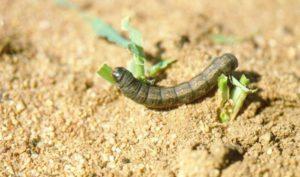Winter scoop: photos and features of the nature of the pest
The winter scoop poses a great danger to plants. It is referred to as a nibbling variety. The peculiarity of this species is its resistance to cold and the ability to survive in winter. The insect feeds on many crops and causes great damage.
Content
What does a winter scoop look like: photo
Description of the winter scoop
Name: Winter Scoop
Latin:Agrotis segetumClass: Insects - Insecta
Squad: Lepidoptera - Lepidoptera
Family: Owls - Noctuidae
 | Habitats: | all over the world |
 | Dangerous for: | beets, oats, millet, sunflower |
 | Means of destruction: | folk, chemical and biological preparations |
Wingspan from 34 to 45 mm. The forewings are brown or almost black in color with a kidney-shaped, round and wedge-shaped spot. These spots are surrounded by a dark border. The hindwings are light grey. They may be almost white. They have a thin dark edging from the outer edge. The females have bristle-like antennae.
The egg has a light yellow color. The diameter is from 0,5 to 0,6 mm, there are radial ribs (from 44 to 47). Pupae are 10 to 20 mm long with a reddish-brown tinge. Last segment of abdomen with 2 spines.
Caterpillars reach 52 mm. They are earthy grey. Rarely greenish. They have a greasy sheen. Body with two closely spaced dark stripes in the upper part and frontal sutures near the occiput.
Life cycle and lifestyle
Activity occurs at night. A dark and calm night with a temperature of at least 12 degrees contributes to enhanced flight. Moths feed on the nectar of honey plants. During the day, their habitat is the leaves of plants and lumps of earth.
On the territory of the Russian Federation, the pest develops in one generation in the central region and northern regions. The area of two generations can be called the southern region. The northern range implies development from 90 to 100 days, and the southern range from 24 to 36 days.
The name of this variety is associated with resistance to frost minus 11 degrees. At this time, the caterpillar is in the ground (depth from 10 to 25 cm). The overwintered caterpillar rises and pupates in a smooth-walled earthen chamber.
Flight in the northern regions falls at the beginning of July, and in the southern regions - at the end of April. The optimum temperature regime is from 15 to 25 degrees. Humidity level from 50 to 80%.
The fertility of moths is affected by the abundance of flowering plants. There is a significant decrease in the population with a lack. The butterfly can lay eggs on its own or with a small colony. The laying place is the underside of the weeds. These include bindweed, plantain, sow thistle. Also choose the plant residue or warmed earth. The site should have loose soil.
The female is able to lay up to 500 eggs. The term of embryonic development is from 3 to 17 days. This is affected by temperature. A temperature of about 30 degrees of heat suggests 4 days, and 12 degrees - about 24 days.
The caterpillar is in the ground. Heavy rainfall leads to the death of young individuals. Initially, they eat on weed grasses, eating away the leaves below. After that, they feed on cultivated plants.
Economic importance
Winter scoops are particularly gluttonous and prolific. The caterpillar destroys wheat and winter rye. It gnaws through the stems. This is fraught with thinning of crops. They feed on beet roots, which leads to slower growth and reduced fruit weight. In a vegetable culture, they gnaw holes in young leaves or eat them whole.
In the central and northern regions of the Russian Federation, it feeds on rye and potatoes, and in the southern region, it feeds on corn, tobacco, millet, and cereals.
How to deal with the winter scoop
Methods of combating the cold-resistant armyworm include luring birds, the use of safe folk methods or chemicals, with severe damage.
Chemical and biological control methods
It is not recommended to treat vegetables with chemicals. It is enough to place chopped white or ordinary gauze, bindweed near the beds. Pre-weeds are sprayed with chemicals.
Folk ways
To scare away butterflies, calendula, cilantro, basil are planted among vegetables. Insects cannot stand the smell of plants such as onions, burdock, potato tops, garlic, wormwood. Choose one of the plants and combine with water in a ratio of 1:2. Insist 3 days. Add to 5 liters of water. Laundry soap (30 g) is rubbed and added to the mixture. Sprayed with an interval of 7 days.
Among 6 ways to deal with the owl, everyone will find effective.
preventive measures
For pest control:
- alternate cultures;
- do early plowing after the collection of nitrogen-accumulating plants;
- garden crops are planted in zones;
- clear the roadside of dry grass;
- observe crop rotation;
- process insects taking into account vegetation;
- carry out autumn plowing;
- tubers are processed before planting;
- destroy weeds;
- process aisles;
- loosen the earth.
Conclusion
When caterpillars of the winter scoops appear, they begin to spray the plants. Processing will help preserve crops, and preventive measures will prevent the appearance of pests.
Previous
